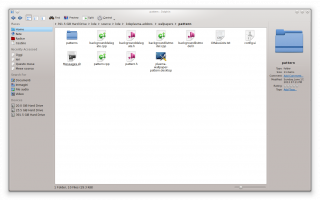Dolphin
Appearance
 |
Kullanıma odaklanmış dosya yöneticisi |
Özellik Özeti
İlk bakışta sade bir dosya yöneticisi olarak görünür ancak çok yeteneklidir. Bazı yetenekleri:
- Pencere bölme - iki dizini aynı anda görüntüleyin ve kullanın
- Ayrı her pencere için bağımsız olarak ayarlanabilen (ve hatırlanılan) görünüm nitelikleri
- Sekmeli gezinti
- Sağda isteğe bağlı bilgi paneli
- Pencerede gösterilmesini istediğiniz önemli nitelik bilgilerini seçin
- Hızlı gezinti için breadcrumb (kırılabilir) gezinti çubuğunu kullanın
- Tek tuşla değiştirilebilir gezinti çubuğu
- Geleneksel gezinti için Klasör Ekleme paneli
- Şuan gezdiğiniz dizin içerisinde terminali açma
- Çoğu işlevler klavye kısayolları ile kontrol edilir
Öğreticiler
Hints, Tips and Troubleshooting
Problem: Dolphin's menu entries and/or don't have any options. Nepomuk is enabled in System Settings.
- Solution: Rename the folder ~/.kde4/share/apps/dolphin (in some distros it will be ~/.kde/share/apps/dolphin) and restart dolphin. This will purge your dolphin customizations but the entries should be back. If everything works as expected you can then delete the folder. This happened to me after an upgrade from KDE 4.4 to 4.5
Problem: When I choose the application to open a specific filetype with, it seems to affect other filetypes too. It’s like Dolphin cannot tell the difference between the two different filetypes.
- Solution: Probably the KDE platform does not know about one of the two filetypes, so it associates the filetype to a different, known filetype. This is common with XML-based filetypes; even if they use a file extension of their own (e.g. .xliff or .graphml), if they are not a filetype known by the KDE platform, they will be treated as any other XML file, and opened with the default application to open XML files.
- To solve this issue, you can use File Associations to create an entry for the unrecognized filetype.
Also see the Dolphin Website and the Dolphin Handbook.
Keywords
File management, file manager, file browser, tags, metadata, Nepomuk
